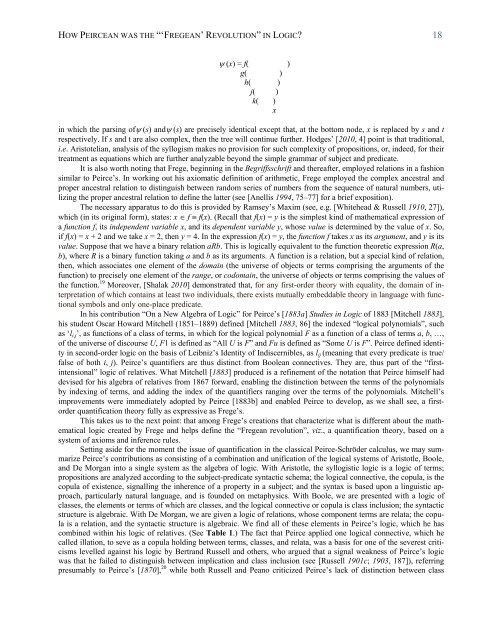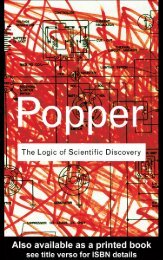Create successful ePaper yourself
Turn your PDF publications into a flip-book with our unique Google optimized e-Paper software.
HOW PEIRCEAN WAS THE “‘FREGEAN’ REVOLUTION” IN LOGIC? 18<br />
�����(x) = f( )<br />
g( )<br />
h( )<br />
j( )<br />
k( )<br />
x<br />
in which the parsing of��(s) and��(s) are precisely identical except that, at the bottom node, x is replaced by s and t<br />
respectively. If s and t are also complex, then the tree will continue further. Hodges’ [2010, 4] point is that traditional,<br />
i.e. Aristotelian, analysis of the syllogism makes no provision for such complexity of propositions, or, indeed, for their<br />
treatment as equations which are further analyzable beyond the simple grammar of subject and predicate.<br />
It is also worth noting that Frege, beginning in the Begriffsschrift and thereafter, employed relations in a fashion<br />
similar to Peirce’s. In working out his axiomatic definition of arithmetic, Frege employed the complex ancestral and<br />
proper ancestral relation to distinguish between random series of numbers from the sequence of natural numbers, utilizing<br />
the proper ancestral relation to define the latter (see [Anellis 1994, 75–77] for a brief exposition).<br />
The necessary apparatus to do this is provided by Ramsey’s Maxim (see, e.g. [Whitehead & Russell 1910, 27]),<br />
which (in its original form), states: x � f � f(x). (Recall that f(x) = y is the simplest kind of mathematical expression of<br />
a function f, its independent variable x, and its dependent variable y, whose value is determined by the value of x. So,<br />
if f(x) = x + 2 and we take x = 2, then y = 4. In the expression f(x) = y, the function f takes x as its argument, and y is its<br />
value. Suppose that we have a binary relation aRb. This is logically equivalent to the function theoretic expression R(a,<br />
b), where R is a binary function taking a and b as its arguments. A function is a relation, but a special kind of relation,<br />
then, which associates one element of the domain (the universe of objects or terms comprising the arguments of the<br />
function) to precisely one element of the range, or codomain, the universe of objects or terms comprising the values of<br />
the function. 19 Moreover, [Shalak 2010] demonstrated that, for any first-order theory with equality, the domain of interpretation<br />
of which contains at least two individuals, there exists mutually embeddable theory in language with functional<br />
symbols and only one-place predicate.<br />
In his contribution “On a New Algebra of Logic” for Peirce’s [1883a] Studies in Logic of 1883 [Mitchell 1883],<br />
his student Oscar Howard Mitchell (1851–1889) defined [Mitchell 1883, 86] the indexed “logical polynomials”, such<br />
as ‘li,j’, as functions of a class of terms, in which for the logical polynomial F as a function of a class of terms a, b, …,<br />
of the universe of discourse U, F1 is defined as “All U is F” and Fu is defined as “Some U is F”. Peirce defined identity<br />
in second-order logic on the basis of Leibniz’s Identity of Indiscernibles, as lij (meaning that every predicate is true/<br />
false of both i, j). Peirce’s quantifiers are thus distinct from Boolean connectives. They are, thus part of the “firstintensional”<br />
logic of relatives. What Mitchell [1883] produced is a refinement of the notation that Peirce himself had<br />
devised for his algebra of relatives from 1867 forward, enabling the distinction between the terms of the polynomials<br />
by indexing of terms, and adding the index of the quantifiers ranging over the terms of the polynomials. Mitchell’s<br />
improvements were immediately adopted by Peirce [1883b] and enabled Peirce to develop, as we shall see, a firstorder<br />
quantification theory fully as expressive as Frege’s.<br />
This takes us to the next point: that among Frege’s creations that characterize what is different about the mathematical<br />
logic created by Frege and helps define the “Fregean <strong>revolu</strong>tion”, viz., a quantification theory, based on a<br />
system of axioms and inference rules.<br />
Setting aside for the moment the issue of quantification in the classical Peirce-Schröder calculus, we may summarize<br />
Peirce’s contributions as consisting of a combination and unification of the logical systems of Aristotle, Boole,<br />
and De Morgan into a single system as the algebra of logic. With Aristotle, the syllogistic logic is a logic of terms;<br />
propositions are analyzed according to the subject-predicate syntactic schema; the logical connective, the copula, is the<br />
copula of existence, signalling the inherence of a property in a subject; and the syntax is based upon a linguistic approach,<br />
particularly natural language, and is founded on metaphysics. With Boole, we are presented with a logic of<br />
classes, the elements or terms of which are classes, and the logical connective or copula is class inclusion; the syntactic<br />
structure is algebraic. With De Morgan, we are given a logic of relations, whose component terms are relata; the copula<br />
is a relation, and the syntactic structure is algebraic. We find all of these elements in Peirce’s logic, which he has<br />
combined within his logic of relatives. (See Table 1.) The fact that Peirce applied one logical connective, which he<br />
called illation, to seve as a copula holding between terms, classes, and relata, was a basis for one of the severest criticisms<br />
levelled against his logic by Bertrand Russell and others, who argued that a signal weakness of Peirce’s logic<br />
was that he failed to distinguish between implication and class inclusion (see [Russell 1901c; 1903, 187]), referring<br />
presumably to Peirce’s [1870], 20 while both Russell and Peano criticized Peirce’s lack of distinction between class





